Effect of Alternate Drying Techniques on Cross-Laminated Timber after Exposure to Free-Water Wetting
Abstract
1. Introduction
2. Materials and Methods
2.1. Materials
2.2. Coring Methodology
2.3. Moisture Uptake
2.4. Ambient Drying
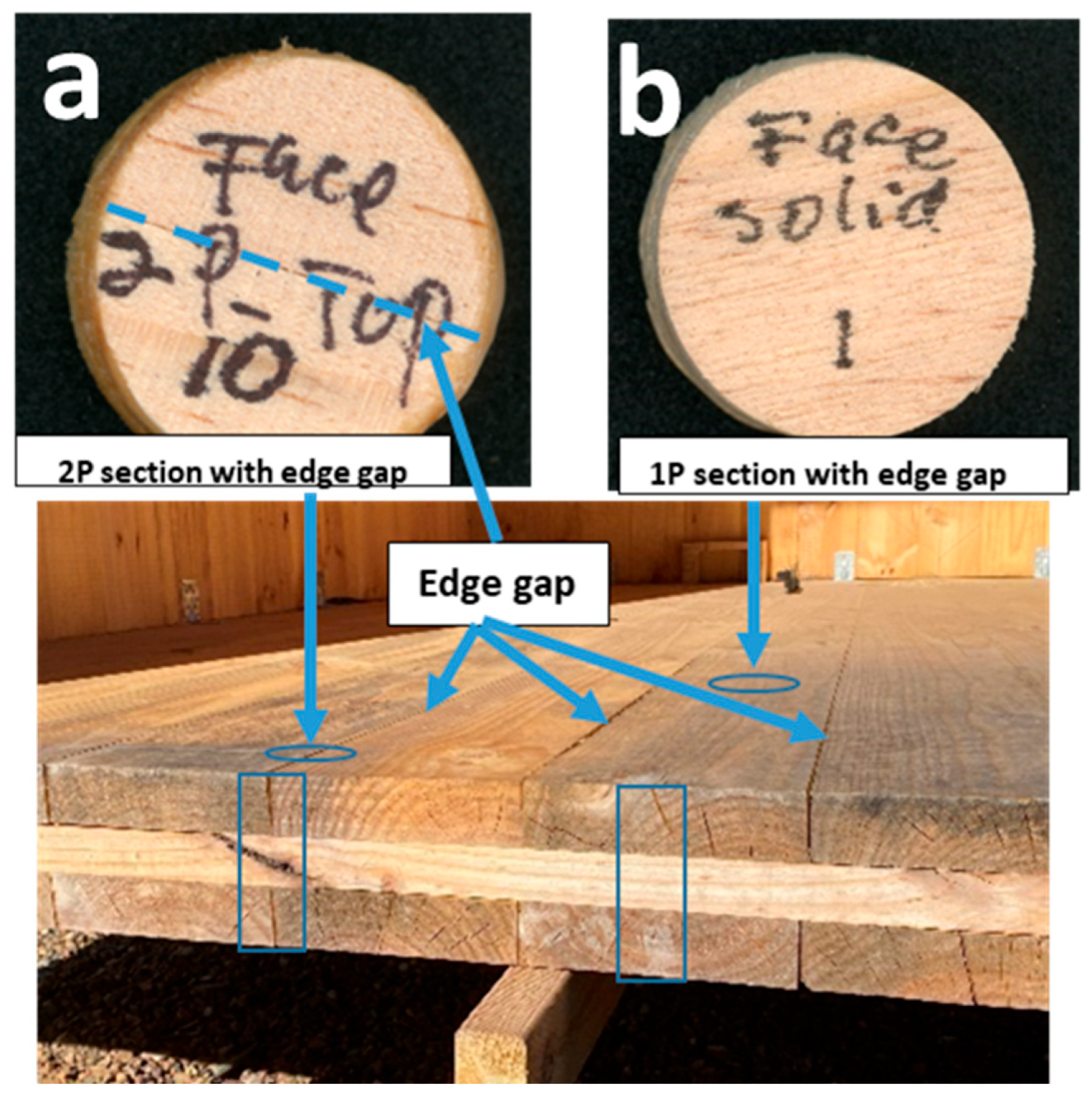
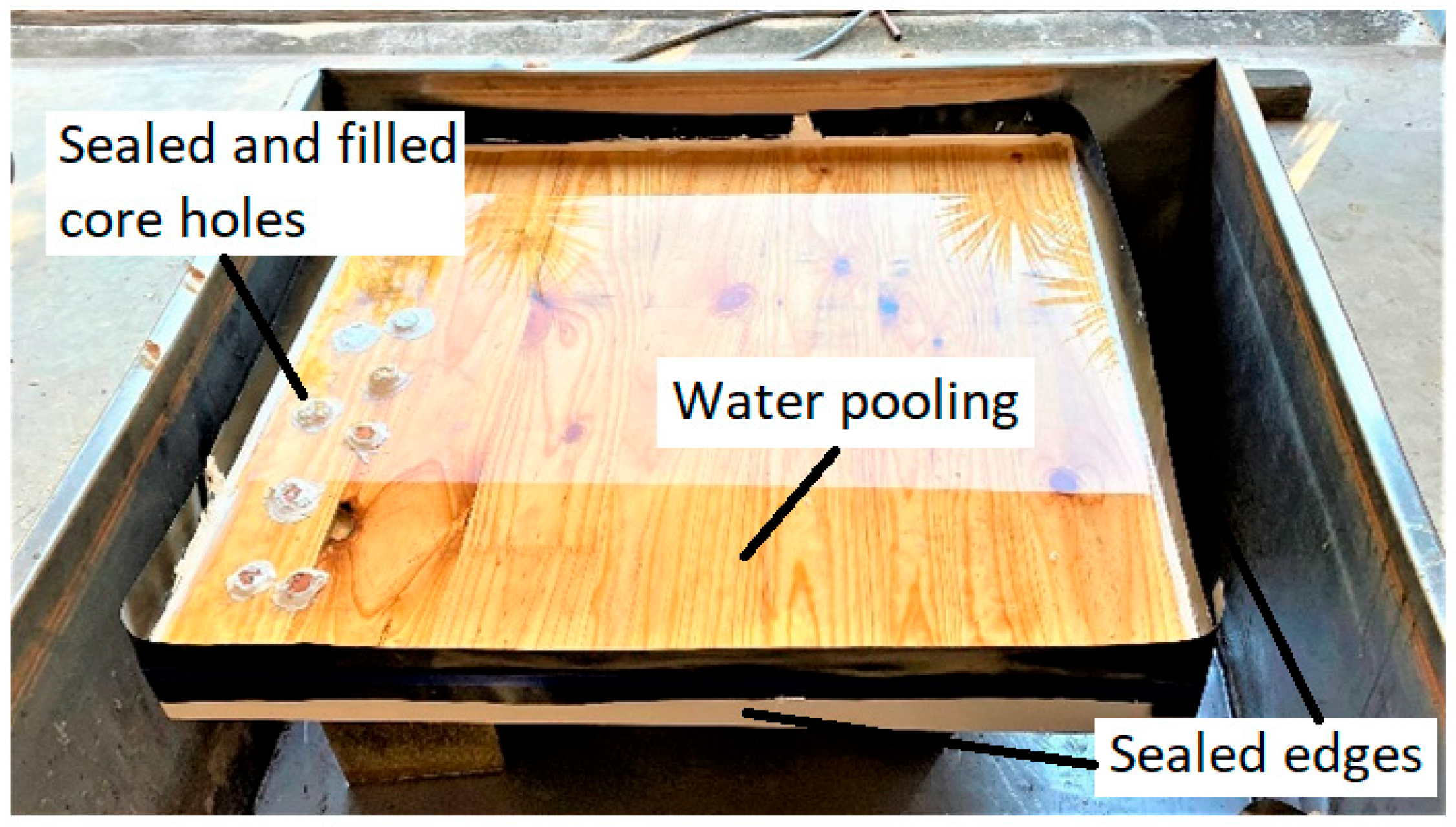
2.5. Fan Drying
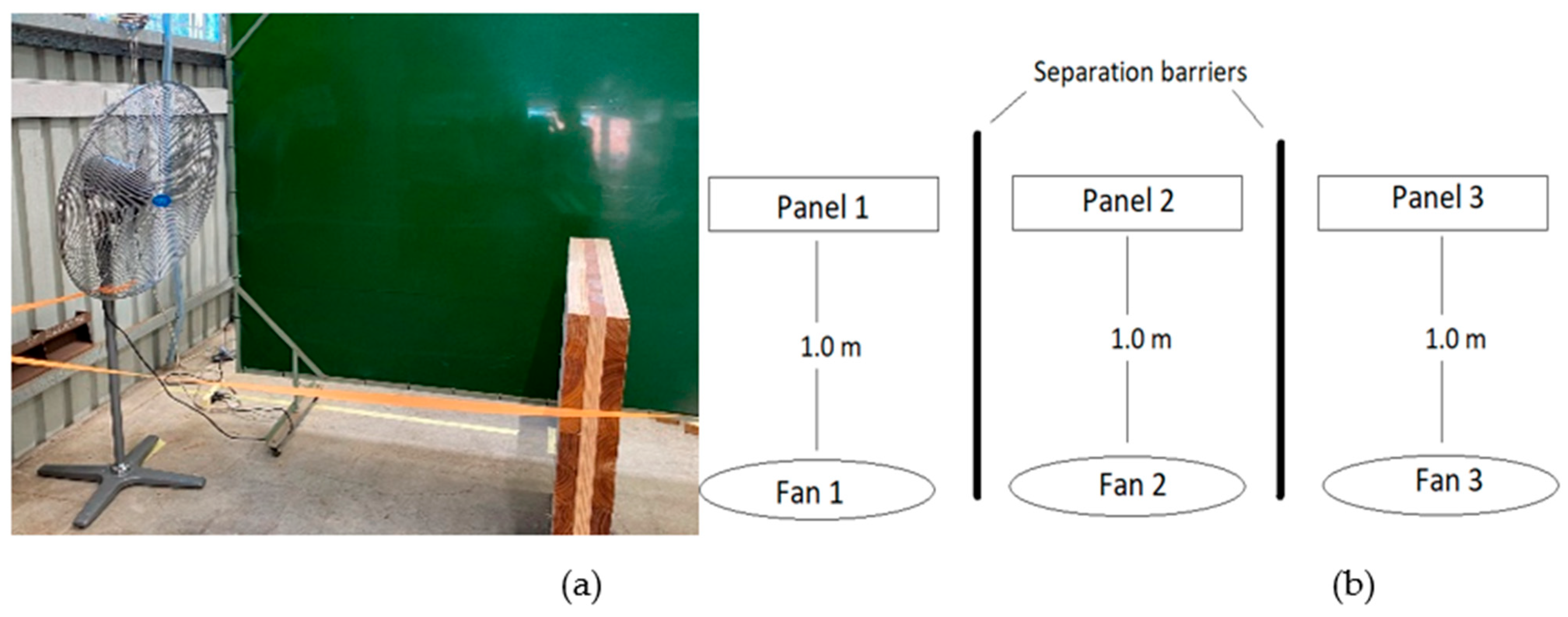
2.6. CLT Structure Drying
2.7. Statistical Analysis
3. Results and Discussion
3.1. Investigative Study
3.1.1. Ambient Drying
3.1.2. Fan Drying
3.1.3. Ambient and Fan Drying Comparison
3.2. CLT Structure Drying
4. Conclusions
Author Contributions
Funding
Acknowledgments
Conflicts of Interest
References
- Montana Ledger. Global Cross-Laminated Timber Market to Reach US$ 2,470 Mn by 2026, in Transperancy Market Research. 2019. Available online: https://montana-ledger.com/global-cross-laminated-timber-market-to-reach-us-2470-mn-by-2026/329947/ (accessed on 10 April 2023).
- Brandner, R.; Flatscher, G.; Ringhofer, A.; Schickhofer, G.; Thiel, A. Cross laminated timber (CLT): Overview and development. Eur. J. Wood Prod. 2016, 74, 331–351. [Google Scholar] [CrossRef]
- Cazemier, D.S. Comparing cross laminated timber with concrete and steel: A financial analysis of two buildings in Australia. Modul. Offsite Constr. (MOC) Summit Proc. 2017, 1, 184–196. [Google Scholar] [CrossRef]
- Gereke, T.; Schnider, T.; Hurst, A.; Niemz, P. Identification of moisture-induced stresses in cross-laminated wood panels from beech wood (Fagus sylvatica L.). Wood Sci. Technol. 2009, 43, 301–315. [Google Scholar] [CrossRef]
- Glass, S.V.; Wang, J.; Easley, S.; Finch, G. Chapter 10: Enclosure—Building enclosure design for cross-laminated timber construction. In CLT Handbook: Cross-Laminated Timber; Karacabeyli, E., Douglas, B., Eds.; Forest Products Laboratory: Madison, WI, USA, 2013; Volume 10, pp. 1–55. ISSN 1925-0495. [Google Scholar]
- Schmidt, E.; Riggio, M. Monitoring Moisture Performance of Cross-Laminated Timber Building Elements during Construction. Buildings 2019, 9, 144. [Google Scholar] [CrossRef]
- Shirmohammadi, M.; Leggate, W. Report on Industry Current Needs and Future Requirements—Investigating the Effects of Moisture Ingress on the Performance and Service Life of Mass Timber Panels in Australian Climates. Department of Agriculture and Fisheries, Queensland Government: Internal Report. Unpublished Work. 2020. [Google Scholar]
- Wang, L.; Wang, J.; Ge, H. Wetting and drying performance of cross-laminated timber related to on-site moisture protections: Field measurements and hygrothermal simulations. E3S Web Conf. 2020, 172, 10003. [Google Scholar] [CrossRef]
- IIMARC Group Research and Markets. Cross-Laminated Timber Market: Global Industry Trends, Share, Size, Growth, Opportunity and Forecast 2022–2027; IIMARC Group Research and Markets: Noida, India, 2022; p. 147. [Google Scholar]
- Mass Timber: Wood Is Prominent in Construction’s Future, Value for Carbon Removal to Be Determined, in the Economist Interrligence Unit. Available online: https://carbonremoval.economist.com/mass-timber/ (accessed on 10 April 2023).
- Cappellazzi, J.; Konkler, M.J.; Sinha, A.; Morrell, J.J. Potential for decay in mass timber elements: A review of the risks and identifying possible solutions. Wood Mater. Sci. Eng. 2020, 15, 351–360. [Google Scholar] [CrossRef]
- Mankowski, M.; Shelton, T.G.; Kirker, G.; Morrell, J. Post-layup protection of mass timber elements in above ground protected exposures: 2-year results. In Proceedings of the 53rd Annual Meeting of the International Research Group on Wood protection, Bled, Slovenia, 29 May–2 June 2022; pp. 1–10. [Google Scholar]
- Udele, K.E.; Morrell, J.J.; Sinha, A. Biological Durability of Cross-Laminated Timber—The State of Things. For. Prod. J. 2021, 71, 124–132. [Google Scholar] [CrossRef]
- McClung, R.; Hua, G.; Straube, J.; Jieying, W. Hygrothermal performance of cross-laminated timber wall assemblies with built-in moisture: Field measurements and simulations. Build. Environ. 2014, 71, 95–110. [Google Scholar] [CrossRef]
- Siau, J.F. Transport Processes in Wood; Springer Science & Business Media: Berlin/Heidelberg, Germany, 2012; Volume 2. [Google Scholar]
- Gezici-Koç, Ö.; Erich, S.J.F.; Huinink, H.P.; Van Der Ven, L.G.J.; Adan, O.C.G. Bound and free water distribution in wood during water uptake and drying as measured by 1D magnetic resonance imaging. Cellulose 2017, 24, 535–553. [Google Scholar] [CrossRef]
- Kukk, V.; Kers, J.; Kalamees, T.; Wang, L.; Ge, H. Impact of built-in moisture on the design of hygrothermally safe cross-laminated timber external walls: A stochastic approach. Build. Environ. 2022, 226, 109736. [Google Scholar] [CrossRef]
- Robbins, C.; Morrell, J.J. Mold, Housing & Wood; Western Wood Products Association: Portland, OR, USA, 2006. [Google Scholar]
- Winandy, J.E.; Morrell, J.J. Improving the utility, performance, and durability of woodand bio-based composites. Ann. For. Sci. 2017, 74, 1–11. [Google Scholar] [CrossRef]
- Zahora, A.R.; Morrell, J.J. Diffusion and sorption of the fumigant methylisothiocyanate in Douglas-fir wood. Wood Fiber Sci. 1989, 1989, 55–66. [Google Scholar]
- Hu, W.-G.; Wan, H. Comparative study on weathering durability property of phenol formaldehyde resin modified sweegum and southern pine specimens. Maderas Cienc. Y Tecnol. 2022, 24. [Google Scholar] [CrossRef]
- Schmidt, E.L.; Riggio, M.; Barbosa, A.R.; Mugabo, I. Environmental response of a CLT floor panel: Lessons for moisture management and monitoring of mass timber buildings. Build. Environ. 2019, 148, 609–622. [Google Scholar] [CrossRef]
- Lipand, R. Capillary Movement of Water in A Radial Direction and Moisture Distribution in a Cross-Section of CLT Panel. Master’s Thesis, Tallinn University of Technology, Talinn, Estonia, 2021; p. 68. [Google Scholar]
- Olsson, L. Moisture safety in CLT construction without weather protection—Case studies, literature review and interviews. E3S Web Conf. 2020, 172, 10001. [Google Scholar] [CrossRef]
- Kordziel, S.; Pei, S.; Glass, S.V.; Zelinka, S.; Tabares-Velasco, P.C. Structure Moisture Monitoring of an 8-Story Mass Timber Building in the Pacific Northwest. J. Arch. Eng. 2019, 25, 04019019. [Google Scholar] [CrossRef]
- Lepage, R. Moisture Response of Wall Assemblies of Cross-Laminated Timber Construction in Cold Canadian Climates; University of Waterloo: Waterloo, ON, Canada, 2012. [Google Scholar]
- Kalbe, K.; Kalamees, T.; Kukk, V.; Ruus, A.; Annuk, A. Wetting circumstances, expected moisture content, and drying performance of CLT end-grain edges based on field measurements and laboratory analysis. Build. Environ. 2022, 221, 109245. [Google Scholar] [CrossRef]
- Bailleres, H.; Lee, C.K.D.; Psaltis, S.; Hopewell, G.; Brancheriau, L. Improving Returns from Southern Pine Plantations through Innovative Resource Characterisation; Forest & Wood Products Australia: Melbourne, Australia, 2019. [Google Scholar]
- Shirmohammadi, S.P.M. Experimental Testing of Moisture Movement in Engineered Wood Product Panels for Numerical Modelling of Panels’ Wetting/Drying During and Post Construction; QLD Department of Agriculture and Fisheries: Brisbane, Australia, 2022. [Google Scholar]
- Australia AS/NZS 1080.1; Timber-Methods of Test-Moisture Content. Standards Australia: Sidney, Australia, 2012.
- Kear, G.; Kell, N.J. Performance of resistance-based moisture meters as a function of timber preservative treatment. N. Z. J. For. Sci. 2008, 38, 271–297. [Google Scholar]
- Genstat. Genstat for Windows 2022; Release 22.1. Available online: https://genstat.kb.vsni.co.uk/download-genstat/ (accessed on 10 January 2022).
- Rowell, J.G.; Walters, D.E. Analysing data with repeated observations on each experimental unit. J. Agric. Sci. 1976, 87, 423–432. [Google Scholar] [CrossRef]
- Kordziel, S.; Glass, S.V.; Boardman, C.R.; Munson, R.A.; Zelinka, S.L.; Pei, S.; Tabares-Velasco, P.C. Hygrothermal characterization and modeling of cross-laminated timber in the building envelope. Build. Environ. 2020, 177, 106866. [Google Scholar] [CrossRef]
- Wang, J. Wetting and drying performance of wood-based assemblies related to on-site moisture management. In Proceedings of the World Conference on Timber Engineering, Vienna, Austria, 22–25 August 2016. [Google Scholar]
- Wang, J. On-Site Moisture Management of Wood Construction; FPInnovation: Pointe-Claire, QC, Canada, 2015. [Google Scholar]
- Wang, J. Construction Moisture Management—Cross Laminated Timber; Stirling, R., Lum, C., Eds.; FPInnovation: Pointe-Claire, QC, Canada, 2020. [Google Scholar]
- Olsson, L. CLT construction without weather protection requires extensive moisture control. J. Build. Phys. 2021, 45, 5–35. [Google Scholar] [CrossRef]
- Kalbe, K.; Kukk, V.; Kalamees, T. Identification and improvement of critical joints in CLT construction without weather protection. E3S Web Conf. 2020, 172, 10002. [Google Scholar] [CrossRef]
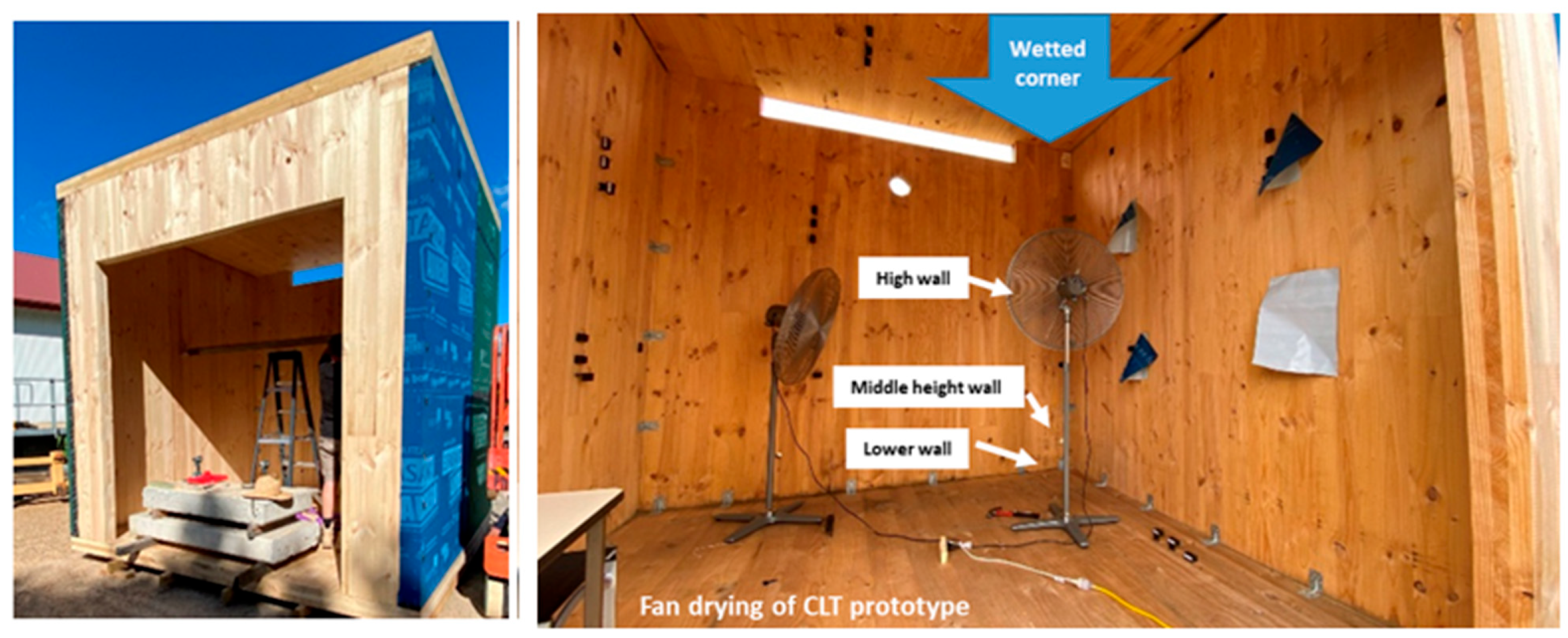
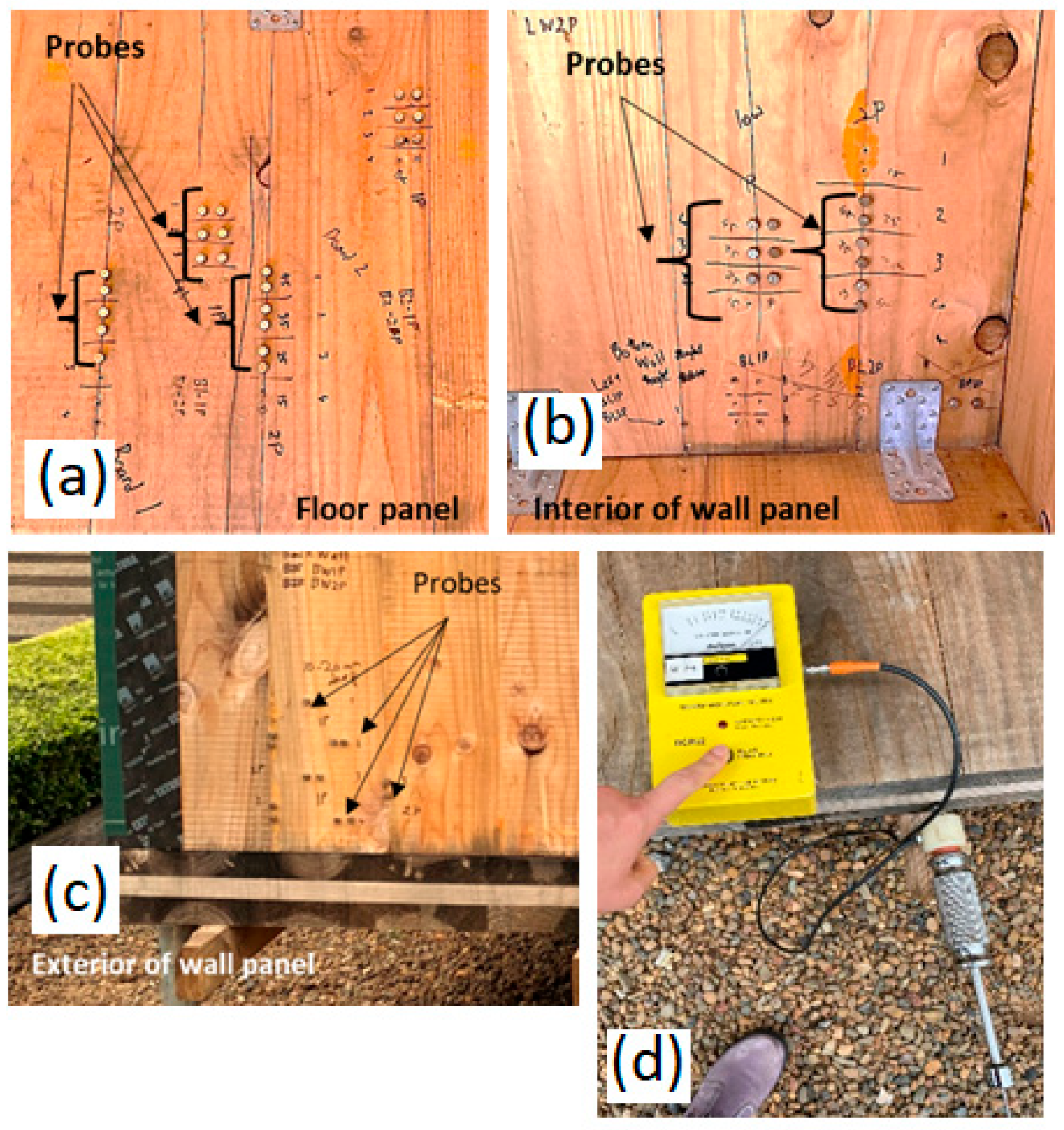

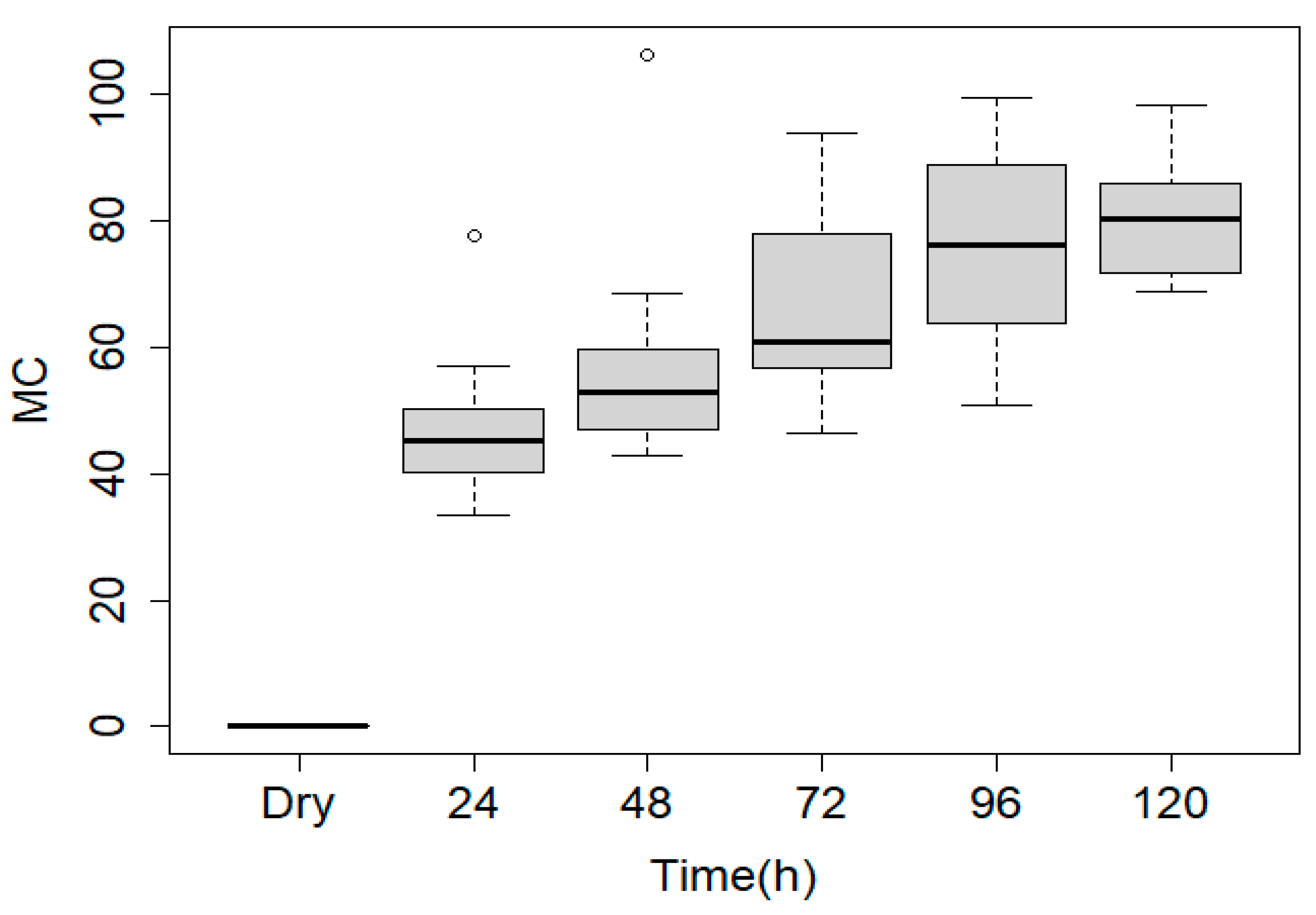
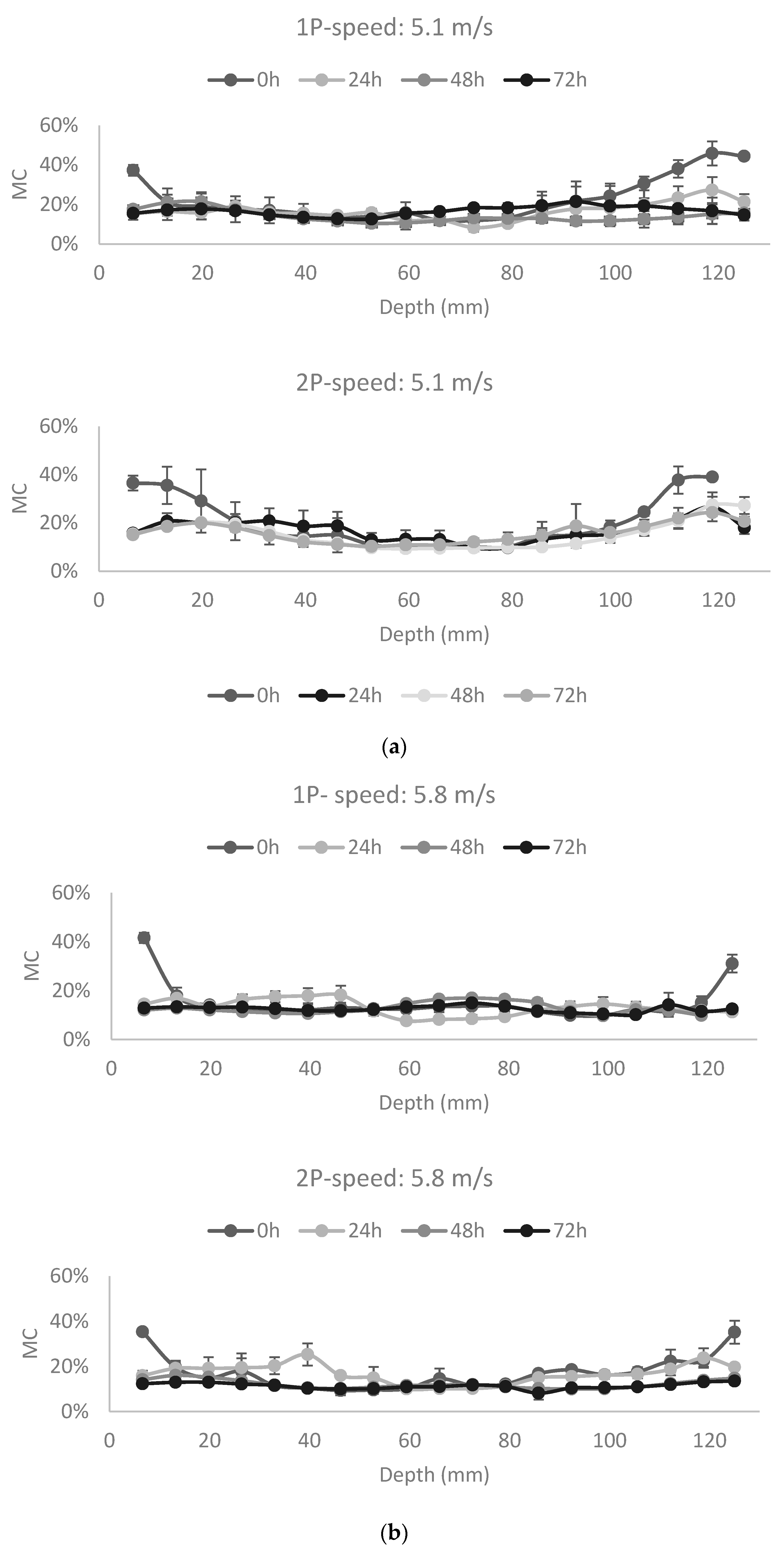
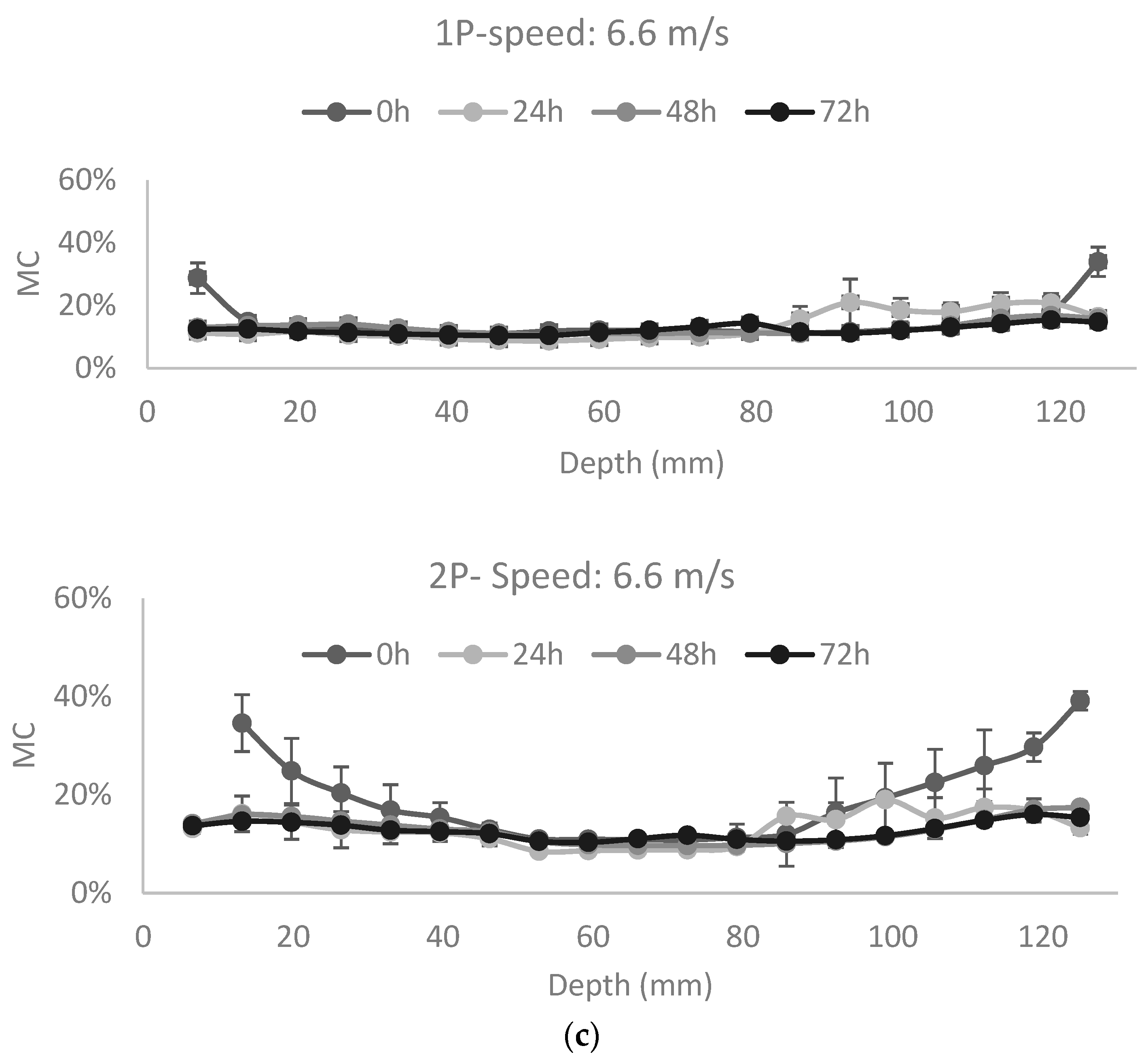
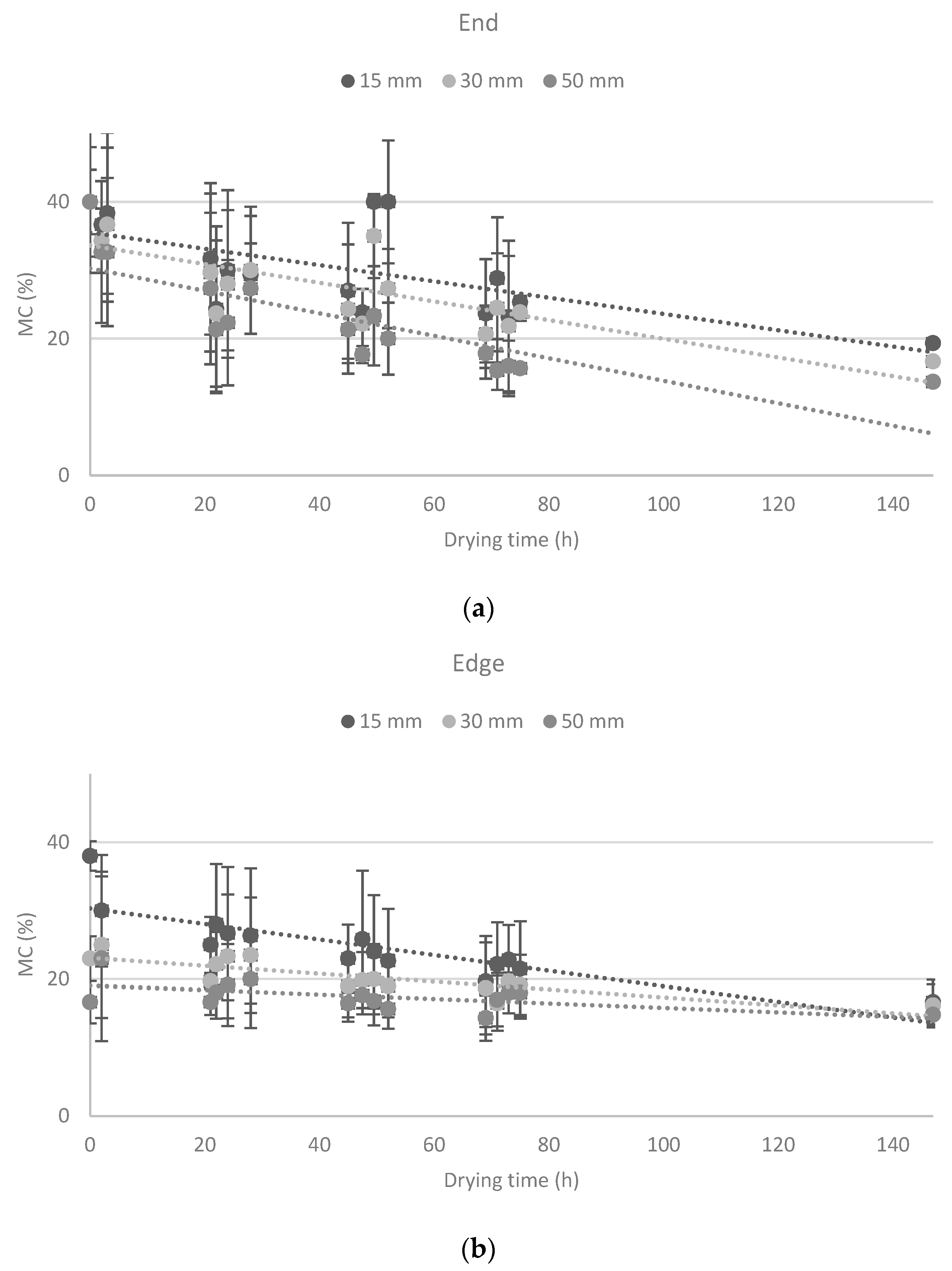
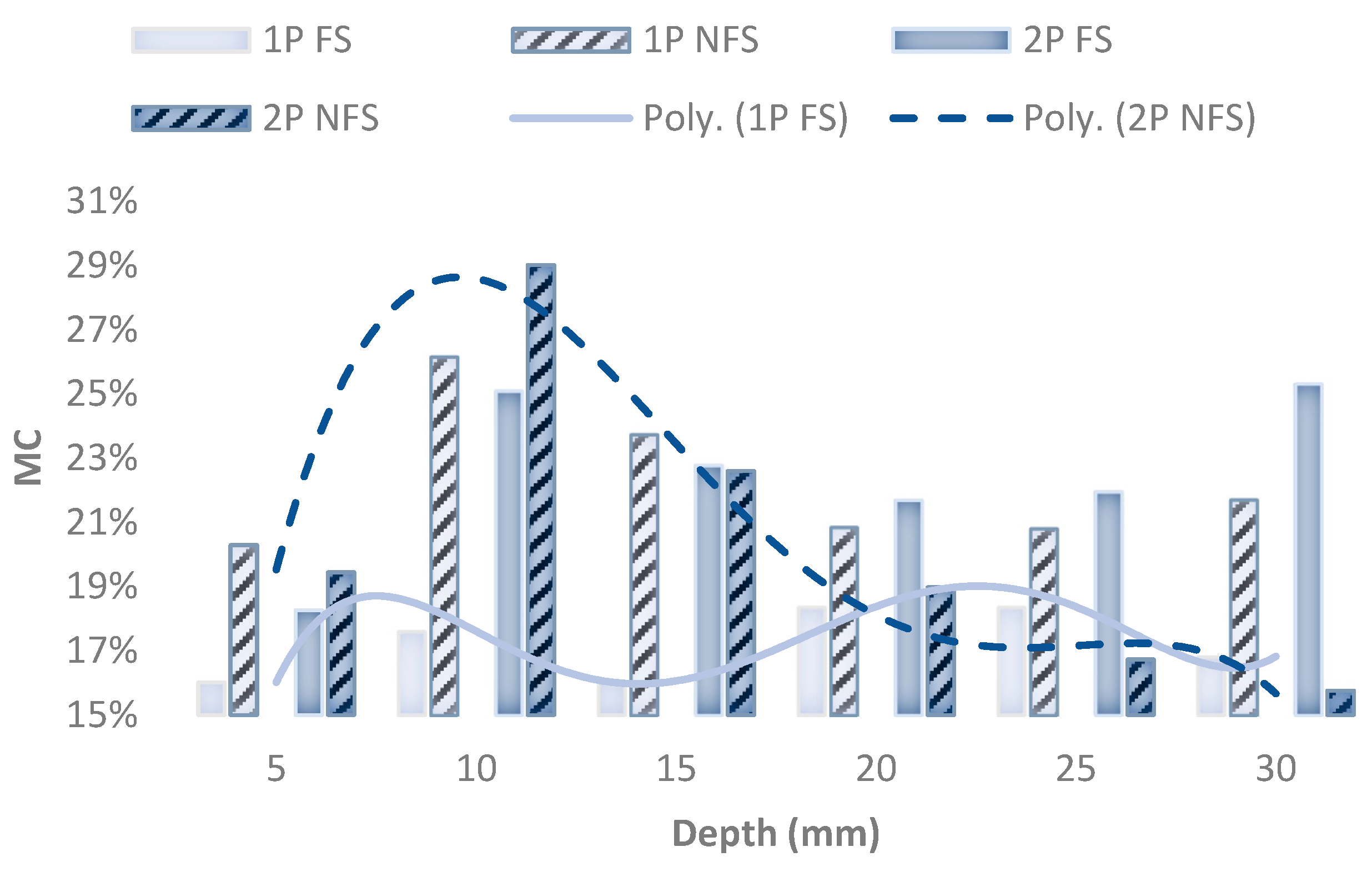

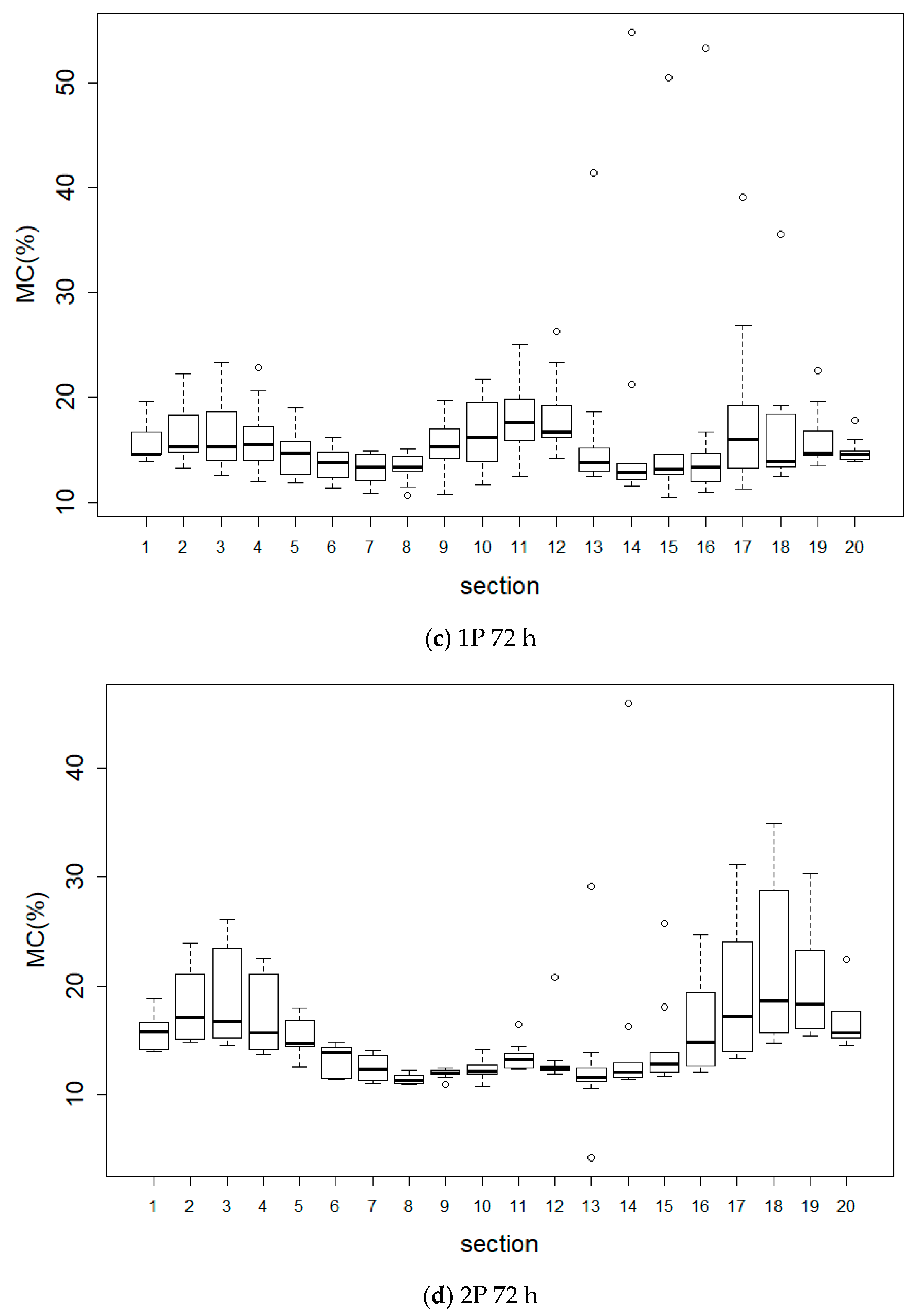


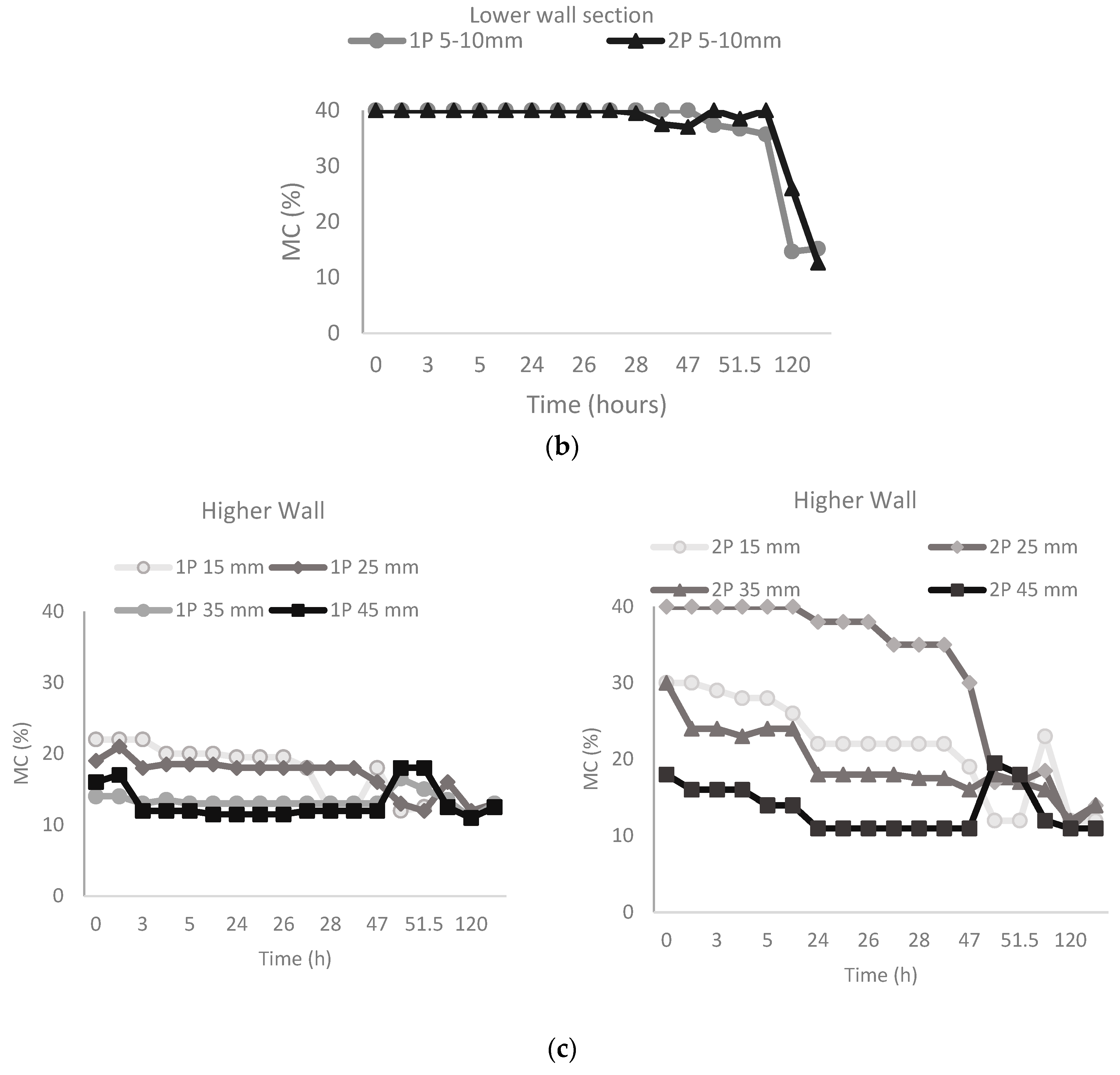
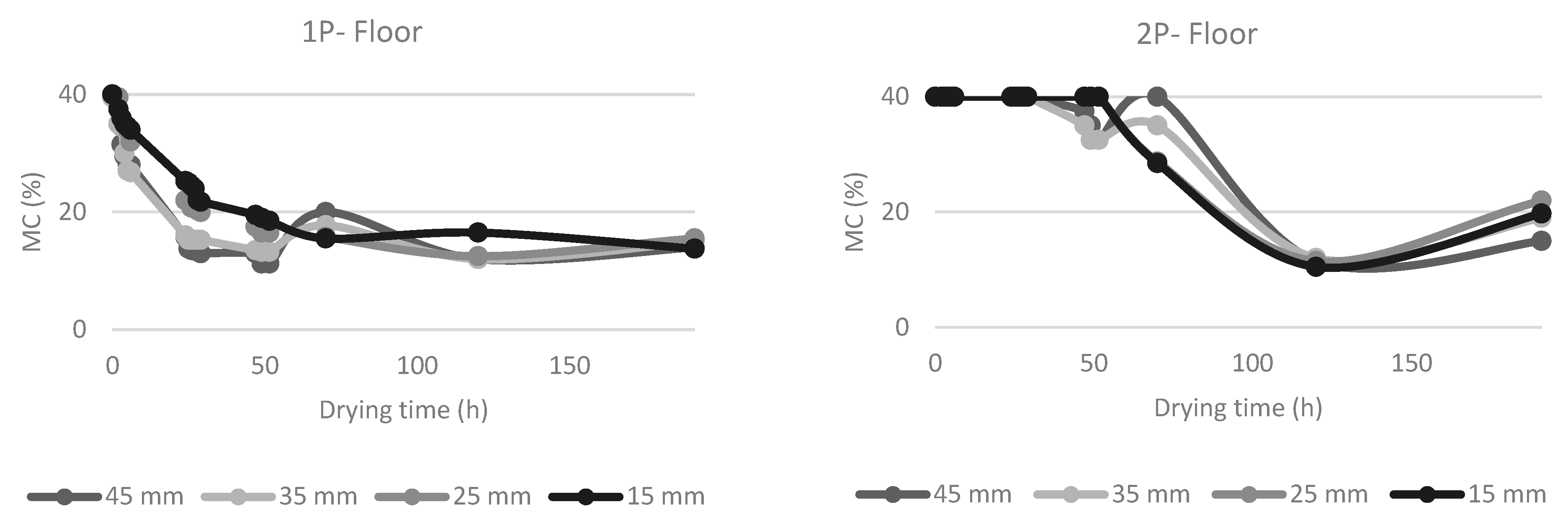

| Test Method | Referenced Sections | No. of Panels | Sample Size (L × W × H) (mm) | No. of Core Samples |
|---|---|---|---|---|
| (a) Moisture uptake | Section 2.3 | 3 × 6 [1] | 40 × 40 × 125 | - |
| (b) Ambient drying | Section 2.4 | 1 | 800 × 850 × 75 | 78 |
| (c) Fan drying | Section 2.5 | 3 | 1000 × 1000 × 125 | 72 |
| Distance (m) | Setting 1 | Setting 2 | Setting 3 |
|---|---|---|---|
| Speed (m/s) [1] | |||
| 0.5 | 5.3 (±0.5) | 6.1 (±0.8) | 6.5 (±1.1) |
| 1.0 | 4.7 (±0.8) | 5.5 (±1.1) | 5.7 (±1.1) |
| 1.5 | 3.9 (±1.0) | 4.6 (±1.1) | 4.9 (±1.1) |
| 2.0 | 3.1 (±0.7) | 3.93 (±0.7) | 4.2 (±1.0) |
| Df | Mean Sq | Pr (>F) | |
|---|---|---|---|
| Type | 1 | 0.0013 | 0.851 |
| Time | 13 | 0.83 | <0.001 |
| Position (depth) | 11 | 5.097 | <0.001 |
| Type:Time | 13 | 0.058 | 0.028 |
| Type:Position | 11 | 0.03 | 0.761 |
| Time:Position | 139 | 0.078 | <0.001 |
| Type:Time:Position | 137 | 0.017 | 0.965 |
| Fan Speed (m/s) | Drying Time (h) | 1P-MC (%) | 2P-MC (%) |
|---|---|---|---|
| - | 0 (wet) | 22.62 ± 16 | 25.71 ± 17 |
| 5.1 | 24 | 20.2 ± 1.7 | 20.1 ± 4 |
| 48 | 16.5 ± 1.5 | 18.2 ± 1.8 | |
| 72 | 20.5 ± 4.1 | 18.7 ± 2.1 | |
| 5.8 | 24 | 14.96 ± 0.4 | 20.4 ± 0.7 |
| 48 | 14.2 ± 0.3 | 13.9 ± 0.8 | |
| 72 | 14.5 ± 0.7 | 13 ± 0.4 | |
| 6.6 | 24 | 15.3 ± 2.4 | 12.7 ± 3 |
| 48 | 14.7 ± 0.2 | 14.6 ± 0.2 | |
| 72 | 14.2 ± 0.3 | 14.6 ± 0.4 |
| Source of Variation | d.f. | Mean | p |
|---|---|---|---|
| Type (1P, 2P) | 1 | 0.00157 | 0.348 |
| Position (depth/section) | 18 | 0.009 | <0.001 |
| Panel Type | 2 | 0.00144 | 0.442 |
| Panel Position | 36 | 0.0026 | <0.001 |
| Type: Position | 18 | 0.0027 | <0.001 |
| Panel: Type: Position | 36 | 0.00098 | <0.001 |
Disclaimer/Publisher’s Note: The statements, opinions and data contained in all publications are solely those of the individual author(s) and contributor(s) and not of MDPI and/or the editor(s). MDPI and/or the editor(s) disclaim responsibility for any injury to people or property resulting from any ideas, methods, instructions or products referred to in the content. |
© 2023 by the authors. Licensee MDPI, Basel, Switzerland. This article is an open access article distributed under the terms and conditions of the Creative Commons Attribution (CC BY) license (https://creativecommons.org/licenses/by/4.0/).
Share and Cite
Shirmohammadi, M.; Faircloth, A. Effect of Alternate Drying Techniques on Cross-Laminated Timber after Exposure to Free-Water Wetting. Forests 2023, 14, 1007. https://doi.org/10.3390/f14051007
Shirmohammadi M, Faircloth A. Effect of Alternate Drying Techniques on Cross-Laminated Timber after Exposure to Free-Water Wetting. Forests. 2023; 14(5):1007. https://doi.org/10.3390/f14051007
Chicago/Turabian StyleShirmohammadi, Maryam, and Adam Faircloth. 2023. "Effect of Alternate Drying Techniques on Cross-Laminated Timber after Exposure to Free-Water Wetting" Forests 14, no. 5: 1007. https://doi.org/10.3390/f14051007
APA StyleShirmohammadi, M., & Faircloth, A. (2023). Effect of Alternate Drying Techniques on Cross-Laminated Timber after Exposure to Free-Water Wetting. Forests, 14(5), 1007. https://doi.org/10.3390/f14051007






